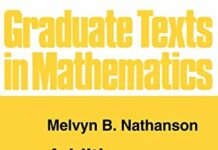
Ebook Info
- Published: 2010
- Number of pages: 356 pages
- Format: PDF
- File Size: 4.40 MB
- Authors: Melvyn B. Nathanson
Description
[Hilbert’s] style has not the terseness of many of our modem authors in mathematics, which is based on the assumption that printer’s labor and paper are costly but the reader’s effort and time are not. H. Weyl [143] The purpose of this book is to describe the classical problems in additive number theory and to introduce the circle method and the sieve method, which are the basic analytical and combinatorial tools used to attack these problems. This book is intended for students who want to lel?Ill additive number theory, not for experts who already know it. For this reason, proofs include many “unnecessary” and “obvious” steps; this is by design. The archetypical theorem in additive number theory is due to Lagrange: Every nonnegative integer is the sum of four squares. In general, the set A of nonnegative integers is called an additive basis of order h if every nonnegative integer can be written as the sum of h not necessarily distinct elements of A. Lagrange ‘s theorem is the statement that the squares are a basis of order four. The set A is called a basis offinite order if A is a basis of order h for some positive integer h. Additive number theory is in large part the study of bases of finite order. The classical bases are the squares, cubes, and higher powers; the polygonal numbers; and the prime numbers. The classical questions associated with these bases are Waring’s problem and the Goldbach conjecture.
User’s Reviews
Editorial Reviews: Review From the reviews:“This book provides a very thorough exposition of work to date on two classical problems in additive number theory … . is aimed at students who have some background in number theory and a strong background in real analysis. A novel feature of the book, and one that makes it very easy to read, is that all the calculations are written out in full – there are no steps ‘left to the reader’. … The book also includes a large number of exercises … .” (Allen Stenger, The Mathematical Association of America, August, 2010)
Reviews from Amazon users which were colected at the time this book was published on the website:
⭐I came to this book for the material on Diophantine approximation and Weyl’s inequality in Chapter 4, and on Vinogradov’s estimate on exponential sums over primes in Chapter 8. Chapter 8 of this book proves an estimate on the number of ways an odd integer can be written as a sum of three primes. This is proved using the circle method and Vinogradov’s estimate. In fact, I think that this chapter is the best place to learn the circle method from. Results from prime number theory are invoked, like Chebyshev’s estimate and the Siegel-Walfisz theorem on primes in arithmetic progressions. Also estimates on sums of fractional parts are used (from Diophantine approximation), which are proved in Chapter 4. No heavy measure theory, harmonic analysis, or complex analysis is used.The other big results in this book are the following: the Hardy-Littlewood estimate for Waring’s problem, Hilbert’s solution of Waring’s problem, the polygonal number theorem, Schnirelmann’s theorem that there is some N such that any integer greater than 1 is the sum of at most N primes, and Chen’s theorem that every sufficiently large even integer is the sum of a prime and an integer that is either prime or the product of two primes.Nathanson is a much more thorough writer than Vaughan
⭐, whose book is good but frustratingly compressed.
⭐Advanced graduate level text in additive number theory, covers the classical bases. This book is the first comprehensive treatment of the subject in 40 years. If the topic of additive number theory interests you, then this is the book to get as there is no comparable (single) book available. Requires a solid understanding of complex analysis. Note, a nice introduction to additive number theory can be found in Hardy and Wright’s Introduction to Number Theory.Some highlights: 1) Chen’s theorem that every sufficiently large even integer is the sum of a prime and a number that is either prime or the product of two primes. 2) Brun’s sieve for upper bound on the number of twin primes. 3) Vinogradov’s simplification of the Hardy, Littlewood, and Ramanujan’s circle method.
Keywords
Free Download Additive Number Theory The Classical Bases (Graduate Texts in Mathematics, 164) in PDF format
Additive Number Theory The Classical Bases (Graduate Texts in Mathematics, 164) PDF Free Download
Download Additive Number Theory The Classical Bases (Graduate Texts in Mathematics, 164) 2010 PDF Free
Additive Number Theory The Classical Bases (Graduate Texts in Mathematics, 164) 2010 PDF Free Download
Download Additive Number Theory The Classical Bases (Graduate Texts in Mathematics, 164) PDF
Free Download Ebook Additive Number Theory The Classical Bases (Graduate Texts in Mathematics, 164)

